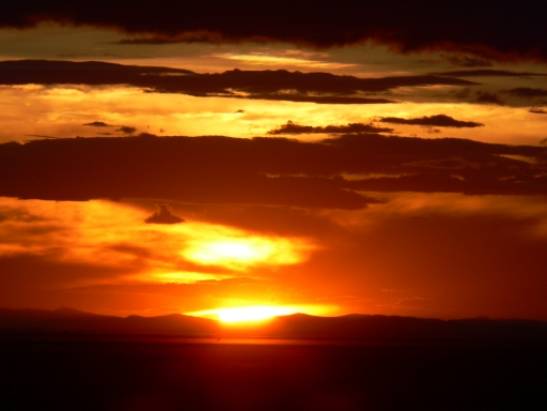| Timbuktu | Africa Safari | Tanzania | Kilimanjaro |
“Karibu!”
Welcome to Tanzania & Mt. Kilimanjaro
Kristina’s escorted Safari
Feb 5-21, 2006
Plus
Kilimanjaro Trek to the top of Africa
Feb 16-March 01
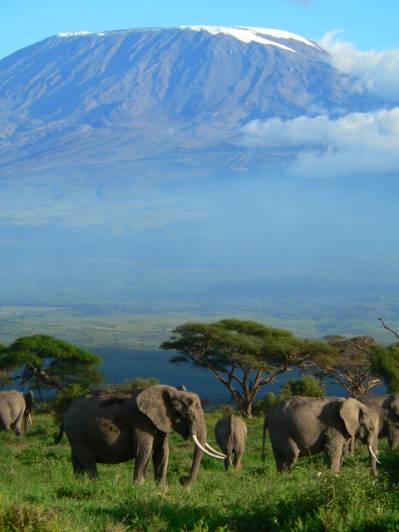
Picture taken from Amboseli NP, Kenya by Kristina April 2005
What is a Safari exactly?
- An expedition involving wildlife observation and tracking.
- A journey of discovery.
- A pilgrimage. Travel as a life experience.
Safari Itinerary at a glance*
Feb.
- Date: Activity
/ Where / What
Accommodations
Sun
– 05
Depart USA
Night on the plane
Mon – 06
Arrive Nairobi,Kenya
Stanley's in Nairobi
Tue – 07
Fly to Amboseli NP
Tortilis Tented camp
Wed – 08
Amboseli NP
Tortilis Tented camp
Thu – 09
Drive to Tarangire NP
Tarangire Treetops
Fri – 10
Tarangire NP
Tarangire Treetops
Sat – 11
Tarangire NP
Tarangire Treetops
Sun – 12
Drive to Ngorongoro Crater
Luxury Mobile Camp
Mon – 13
Ngorongoro Crater
Luxury Mobile Camp
Tue – 14
Olduvai Gorge & the Serengeti Luxury
Mobile Camp
Wed – 15
Serengeti Safari
Luxury Mobile Camp
Thu – 16
Serengeti Safari
Luxury Mobile Camp
Fri – 17
Serengeti Safari
Luxury Mobile Camp
Sat – 18
End safari/Fly to Arusha
KIA Lodge, Arusha
Sun – 19
Fly to Nairobi
Giraffe Manor
Mon - 20
Day room at G. M.
Evening flight to USA
---------------------------------------------------------
Kilimanjaro extension
Thu
– 16 Day -2
Depart USA
night on plane
Fri – 17 Day -1
Arrive Arusha KIA
Lodge
Sat - 18 Day 1
Start of Trek KIA
Lodge
Sun – 19 Day 2
5,500 feet
West Kilimanjaro Base Camp
Mon – 20 Day 3
9,500 feet
Forest Camp
Tue – 21 Day 4
12,200 feet
Shira 1 Camp
Wed – 22 Day 5
12,600 feet
Shira 2 Camp
Thu – 23 Day 6
13,800 feet
Moir Camp
Fri – 24 Day 7
15,000 feet
Lava Tower Camp
Sat – 25 Day 8
16,100 feet
Arrow Glacier Camp
Sun – 26 Day 9
18,750 feet
Crater Camp
Mon – 27 Day 10
19,340 feet
Summit Day Mweka Camp
Tue – 28 Day 11
Descend & Return to USA
Fly Overnight
Wed – 03/01 Day 12
Arrive USA
* Itinerary is subject to changes & availability
Safari
is limited to 8 persons
Trek is limited to 4 hikers
Personalized
Pre and/or Post extensions are available: Please enquire
Space is confirmed when a deposit of $1,000.00 per person is received.
Prices
are per person
Kenya Pre tour extension $1,500.00
Tanzania
safari $6,500.00
Giraffe Manor post extension $600.00
Trek $3850.00
Ask about the single supplement
Kenya Safari
Feb 6-9, 2006
East Africa Safari ~Featuring Nairobi & Amboseli~
February
6 Arrive
Nairobi
The Stanley
February 7
Amboseli
Tortilis Camp B,L,D
February 8
Amboseli
Tortilis Camp B,L,D
February 9
Amboseli drive to the Namanga boarder
B
Price Includes:
-
Flying Doctors Medical Coverage for Kenya
-
Meet & Greet at JKIA
-
Private transfer to The Stanley Hotel
-
1 night at The Stanley Hotel, B&B
The Stanley Hotel is one of Nairobi's most famous landmarks and maintained its reputation as one of the best international-class hotels in the city center. The hotel boasts 220 deluxe rooms, club-rooms and tastefully appointed suites, all of which have been upgraded to supply every modern convenience. You only have to step outside the door for shops and restaurants and the internationally renowned rendezvous point and pavement café, the Thorn Tree Café is within the hotel grounds.
-
Private transfer to Wilson airport
-
Air Kenya flight 7:30am to Tortilis
-
2 Nights Tortilis Camp, Full Board
Tortilis Camp lies on the edge of the Amboseli National Park, in the shadow of Africa's highest peak, Mount Kilimanjaro. Named for the umbrella shaped thorn trees under which it is built, Acacia Tortilis, this tented camp beckons you away from the stresses of life and surrounds you with luxury. Tortilis Camp creates an oasis - a place of peace, a place of solitude. The camp has 17 specially designed luxury tents offering a unique, extra large semi circular verandah. This affords breathtaking views of the snow capped Mt. Kilimanjaro, the highest mountain in Africa, from the privacy of your own tent. Every care has been taken to preserve the natural surroundings and ecosystem. The camp is powered by solar electric panels. The bar and dining areas overlook a water hole which is frequented by elephants and other game. The camp sits on the edge of the park on land owned by the local Maasai.
Tortilis Camp offers a wide variety of activities ranging from early morning and mid-afternoon game drives, guided game walks led by a Maasai guide outside the park, and hilltop sundowners. Alternatively, you can laze around the pool enjoying drinks and the stunning view.
Working closely with the local Maasai people, it is managed as an ecotourism lodge, winning the British Airways "Tourism for Tomorrow Award" in 1995 for its excellence in responsible tourism. In 1996 Travel News Magazine awarded it the "Best Tented Camp" in East Africa. Visits to the nearby village (bomas) give guests an insider’s view of the way of life that has remained unchanged for centuries.
-
Private transfer from Tortilis to Tanzania at the Namanga boarder
-
Park Entry fees
-
Game drives in 4 x 4 vehicles
-
Laundry and local drinks, beer & wine & soft drinks at Tortilis
-
All transfers from airstrips to camp All domestic flight departure taxes
Amboseli National Park
Amboseli is famous for its big game - elephants, lions and cheetahs are the main attractions - and for its great scenery & beauty. Amboseli embodies five main wildlife habitats, plus a generally dry lake-bed - Lake Amboseli. These are open plains; extensive stands of yellow-barked acacia woodland; rocky, lava strewn thorn-bush country; swamps and marshes; and at the western end of the reserve, above Namanga, the massif of Ol Doinyo Orok rising to over 2,760m (8.300ft) and still for the most part zoologically unexplored. The landscape is dominated by the glistening majestic snow cap of Mt Kilimanjaro immediately to the south.
Amboseli National Park is one of the best places to see elephants in Kenya. In the dry bush country towards Namanga you can find two interesting antelopes; the long -necked gerenuk (giraffe-necked antelope) and the fringe-eared oryx. Bird life is in abundance especially near the lakes and swamps where you may find water birds. The Madagascar Squacco Heron shows up in intervals and the long toed lapwing is a resident in small numbers. Birds of prey include the six species of vultures, the Taita falcon and the Southern branded Harrier eagle.
It is a must to get some pictures of elephants grazing fresh grass from the swamps in front of the Mount Kilimanjaro. To do so, you will need to wake up early (not later than 7 am) as the Kilimanjaro is becoming a mass of clouds after 10 am (even if the sky is blue and unclouded). Then, go around the main Ol Tukai and Olokenya swamps as elephants are coming down from the mountain to feed in the swampy areas. Stop your car, drink your hot coffee and photograph to the sound of pulled out grass!
The Ultimate Tanzania Safari
February 9-19, 2006
Featuring
Tarangire, Ngorongoro, Serengeti & Oldipai Gorge
What’s included
-
All-inclusive Pricing: The prices include all major expenses, meals, accommodations based on double occupancy, and park fees. Virtually the only things that you will need to pay for while on safari are gifts and your own personal expenses.
-
A Tanzanian-born Safari Guide: A guide who will be your companion, your teacher, and at your service throughout your trip
-
Cultural Interaction: Visit a small rural farming village on the slopes of Mt. Meru. This visit is exclusively for Thomson Safaris' guests. Near Ngorongoro Crater we meet the colorful Maasai people as well.
-
All meals in Tanzania are either prepared for you by our expert cooks, or served at your lodge
-
Specially Outfitted Land Rovers: Comfortable game viewing in specially outfitted 4-wheel drive Land Rover Defenders, the ultimate safari vehicles, with roof hatches and video camera charging sockets. You are guaranteed a window seat. Please Note: Our some adventure safari itineraries require the use of a large, open-sided, 4-wheel drive vehicle to carry travelers with all gear and supplies to remote destinations
-
Conservation and Park Fees: Wildlife viewing in Tanzania's most abundant wildlife areas - Tarangire National Park, Ngorongoro Crater and the Serengeti.
-
Bottled Water
-
Baggage Handling
-
Complete Pre-departure Information: After making your reservation, you will receive a package of detailed information to help you prepare for your trip. It includes terms and conditions, pre-departure instructions, a packing list, health requirements, visa regulations and all your flight details.
-
On-site Welcome Orientation: This valuable briefing will help familiarize you with what's ahead, as well as give you practical information about the day-to-day details of your trip.
-
Daily Briefing: A daily safari briefing will help prepare you for the next day of game viewing.
-
Special Excursions and Events as described in your itinerary
-
Internal Flights: Serengeti to Arusha, Kilimanjaro to Nairobi.
Sorry, Price Does Not Include:
-
International Airline Ticket
-
Travel Insurance
-
Change fees & Excess baggage fees
-
Gratuities
-
Beverages & laundry unless mentioned
-
Any other items not specifically mentioned
-
Items of a personal nature
-
Passports and visa fees: USA passport holders require visas for Kenya & Tanzania. These are obtainable at the port of entry into Kenya & Tanzania, payable in cash. The cost for a single entry visa is $50 per person per country. It’s highly advisable to obtain the visas in advance from the respective embassy in Washington DC.
Tanzania
is still wild and untamed: The countryside itself is part of the drama
Tanzania truly is a safari destination without peer
Day by Day itinerary in detail
Thursday February 9
Tarangire
National Park
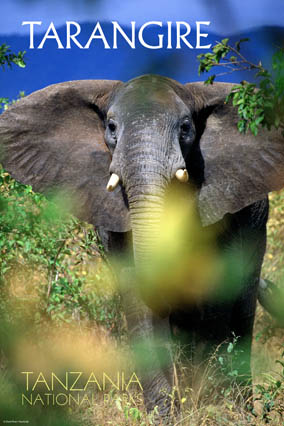 After
breakfast at Tortilis depart for the Namanga border and Tarangire National Park,
Tanzania’s fourth largest. Catch a glimpse of Mount Meru, Kilimanjaro’s
smaller, but similarly dramatic volcanic neighbor, and keep your eyes open to
see Kili itself, should the clouds part to reveal the mountains’ true majesty
After
breakfast at Tortilis depart for the Namanga border and Tarangire National Park,
Tanzania’s fourth largest. Catch a glimpse of Mount Meru, Kilimanjaro’s
smaller, but similarly dramatic volcanic neighbor, and keep your eyes open to
see Kili itself, should the clouds part to reveal the mountains’ true majesty
At the Namanga border meet your Tanzanian safari guide
It is the vast number of baobabs that first capture the eye as you enter Tarangire National Park. The gently rolling countryside is dotted with these majestic trees, which seem to dwarf the animals that feed beneath them. The park is spectacular in the dry season when many of the migratory wildlife species come back to the permanent waters of Tarangire River. June to October is the best time to see large number of wildebeest, elephants, zebras, and hartebeest. Not all animals are migratory though; other animals such as giraffes, Impala, Eland, lesser kudu, waterbuck, gazelle and sometimes rhinos or leopards can be seen throughout the year. More people are attracted by the giant pythons and large herds of elephants. Tarangire's pythons climb trees, as do its lions and leopards, lounging in the branches where the fruit of the sausage tree disguises the twitch of a tail. The park is also famous for migrant birds.
Tarangire National Park covers approximately 2600 square kilometers and, in the dry season, is second only to Ngorongoro Crater Conservation Area in concentrations of wildlife. Tarangire lies to the south of the large, open grass plains of southern Maasailand, and derives its name from the Tarangire River, which provides permanent water for wildlife in the area.
As a holiday destination Tarangire is a lot less busy than other parks in the north of Tanzania. Going on a safari here offers you a chance to savor a real slice of Africa's wilderness and solitude.
Tarangire Treetops
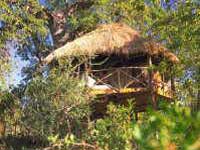 Tarangire Treetops is located
within the 57000 acre Tarangire Conservation Area straddling the wet-season
migration route into the adjacent Tarangire National Park.
Tarangire Treetops is located
within the 57000 acre Tarangire Conservation Area straddling the wet-season
migration route into the adjacent Tarangire National Park.
Located just outside Tarangire National Park, this safari camp is the epitome of rustic luxury. It is small and intimate with delicious meals and a wonderful view over Tarangire's unique landscape. Each en-suite unit has a private veranda and lounge area, with sweeping views over their private Conservation area. Tarangire Treetops features 20 luxury en-suite rooms, built atop tree-attached platforms, overlooking the Tarangire Sand River.
The camp has been superbly blended into the environment with the sleeping platforms built into a variety of Baobab, Mopani and Wild Fig trees.
The dining area is situated close to the swimming pool and elephant water hole is an innovative and stunningly original property consisting of large tree houses built upon platforms amongst a cluster of Baobab, Mopani and Wild Fig Trees. This is one of the premier properties in Northern Tanzania.
Home to a unique ecosystem, the area has all the same species of wildlife as the Tarangire National Park, including buffalo, lion, cheetah, leopard and elephant. Huge herds of elephant frequent the site of the camp on their way to watering in the Sand River, ensuring year-round resident game. The establishment of this camp has also resulted in many developments for the village, including improved water facilities and a school, as a percentage of all visitors’ lodging costs is donated to several village improvement schemes. The camp also offers the unique facility of night drives and game walks, including a special trail for mountain biking. Armed rangers whose knowledge of the bush is legendary accompany all ventures.
Friday February 10
Saturday February 11
Tarangire National Park - Game
Viewing
Continue your exploration of Tarangire today, searching the trees for leopard, watching as elephant play, bathe and socialize near the river and spotting lion, cheetah, hyena, and a multitude of birds as they go about their fascinating daily routines.
Tarangire comes into its own during the dry season (July - November) when enormous populations of elephants and other animals are drawn to the Tarangire River and other sources of permanent water. Game viewing during the transition months of June and December can be fair to good depending on the rains. During the wetter months (January - May) much of the game will be dispersed and out of reach outside of the park. January and February are usually still decent for game viewing but March, April and May offer poor game viewing.
Sunday February 12
Ngorongoro Conservation Area
Ngorongoro Crater
After breakfast, depart for Ngorongoro Crater. As you reach the top of the crater wall, your first glimpse of the crater floor is nothing short of awe-inspiring. The world’s largest unbroken caldera, the crater is a geologic marvel, and in addition, boasts some of the densest wildlife populations in the world. This mini-ecosystem of savanna, forest and small lakes sustains a huge number of non-migratory animals from gazelle, zebra, wildebeest, hyena, hippo and elephant to flamingo, cheetah and African buffalo. In the evening, return to your lodge or camp, perched high on the crater rim.
Unique is a thoroughly overused word, but it really does apply to the Ngorongoro crater. This is the largest unbroken caldera in the world - and it's full of big wild animals. Ngorongoro Crater is only the best known of a large number of volcanic mountains in the area; the underlying geology is the result of volcanic activity along the edge of the Rift Valley some two million years ago.
The Crater, which makes up only 3 percent of the Ngorongoro Conservation Area, is a microcosm of East African habitats and game holding an extraordinary variety and concentration of wildlife.
This is one of the few areas where you have a very good chance of seeing some of East Africa's last wild black rhino, and inside a day you have a very good chance of seeing all of the big five.
Ngorongoro Conservation Area (NCA) of about 828 Sq. Km. is the most perfect caldera of the world. At 18km across, often with nothing we can compare it to, this is one of the wonders of the world! You will be attracted by the relief, its mountains, drifting sand dunes, the diverse wildlife and the Maasai people. Due to these qualities including its being nearer the cradle of mankind, the Olduvai Gorge, The NCA was declared a World Heritage Site in 1978.
This is the only place on the planet where human beings still live in harmony with wildlife without harming one another. To date the only place to witness this is the Ngorogoro Conservation Area.
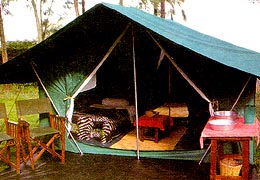
Classic Camping affords the luxury of sharing the wilderness with the wildlife. It is intentionally simple, yet the service goes far beyond what you might expect from even the most comfortable lodge. The charm is in the rusticity, and you will find yourself feeling inexplicably pampered in these quiet and secluded camps.
The Classic Camps are modeled on the traditional mobile tented safari camps enjoyed by Hemmingway and Karen Blixen.
You'll be closer to nature, but not too close for comfort.
We don't believe silver tea sets, Persian carpets, crystal glassware and starched uniforms are particularly appropriate in the wild, but you will be safe and comfortable, and you will receive excellent service and attention from our friendly camp staff.
Each large, walk-in tent has a straw mat floor, two camp beds complete with mattresses, pillows, sheets, blankets, and a bedside table. The tents have fine mesh windows and doors for ventilation and are completely mosquito and bug proof.
Classic Camps provide the utmost in comfort with one enormous benefit: the stars serve as your roof and the gentle breezes as your air-conditioning. Set in parks and private game reserves Classic Camps provide ample space in large, walk-in tents complete with twin beds, linens, a small bedside table, and lighting. Attached is your own private toilet and nearby you'll find a shower tent offering hot showers any time of day.
- Camp will be set up prior to arrival.
- You stay in large walk-in tents equipped with two camp beds, pillows and mattresses, sheets and blankets.
- At the front of each tent is a private veranda with a table, wash basins and two safari chairs
- A sanitary portable toilet is in its own small tent attached at the back of each sleeping tent, along with a shower tent providing hot safari-style showers at any time of day.
- Hot showers are available every day.
- Camp lighting is provided by kerosene lamps.
A separate tent is set apart for dining -- hearty, healthy meals are prepared by our camp cooks, using fresh meats and produce from our own private suppliers. It's all so comfortable, the term "roughing it" simply doesn't apply.
- The dining tent is complete with tables, chairs and tablecloths.
- Our cooks are the best around, presenting delicious, varied, ample meals.
In the evening, after a delicious & healthy meal expertly prepared in an outdoor "kitchen" by our camp chefs and served in the spacious dining tent, retire to the campfire to share stories and marvel at the billions of stars overhead in the endless African sky.
Fall asleep to the sounds of the African night – lions calling to each other in the distance or the eerie howl of hyenas, and maybe even the muffled munching of a buffalo or wildebeest not far away.
This is the most eco-friendly way to travel in Africa, and our travelers say it is one of the most memorable safari experiences.
Monday February 13
Ngorongoro Conservation Area
Today, spend the entire day exploring the crater floor. This is one of the only places in Africa where, if you are lucky, you will have an opportunity to see the extremely rare black rhino and the rest of the “big five” from a uniquely close perspective. Enjoy a picnic lunch as you continue your exploration of this mini-universe, which spans a mere 10 miles across, yet sustains an astounding variety of animals. Among the dozens of species you can expect to see, perhaps you will get a glimpse of the famously venerable bull elephant that roams the crater, showing off his enormous tusks and proving that the elephant is indeed the true “king of beasts.”
Tuesday February 14
Olduvai Gorge / Serengeti National Park
Heading west, depart the Ngorongoro Conservation Area and, on your way to the Serengeti, stop at Olduvai Gorge, an archeological site of extraordinary importance in our understanding of the origins of “man.” Here in these desolate gullies, several generations of the Leakey family toiled for decades in search of prehistoric clues in the mystery of human evolution. The small museum details some of their most important finds, among them the skull of “Zinjanthropus Man” and the 3.6 million year old australopithecine footprints from Laetoli.
From here, continue into the vast Serengeti plains, game viewing and stopping for a picnic lunch as you approach your secluded camp. The wildlife viewing within this eco-system is unparalleled. Some of the largest herds of hoofed animals congregate here: gazelle, wildebeest, zebra, giraffe and buffalo, for example.
From the rustic luxury of your camp, you will have a chance to relax around a roaring campfire, explore the area on a guided walk and fall asleep to the sound of nearby animals. All the while, your attentive camp staff takes care of your every need.
Serengeti National Park
The Serengeti National Park is Tanzania's largest and probably one of the best known in the world. It begins about 100 miles to the west of Arusha. To the east it's bordered by the Ngorongoro Highlands and the Great Rift Valley and to the West by Lake Victoria. The main park which covers around 15,000 sq km is drained to the west by three main rivers, the Mara, Grumetui and Mbalageti Rivers. This area forms only a part of the whole Serengeti ecosystem, which extends to the surrounding game reserves; Maswa to the southwest, Grumeti and Ikorongo controlled areas to the west, Loliondo to the east and the Maasai-mara in Kenya to the north.
The Serengeti is probably best known for the awe inspiring wildebeest migration in which millions of animals circulate through the ecosystem annually, moving onto the 5000 sq km of grassland in the wet and retreating to the woodland areas in the dry.
It's undoubtedly one of the most dramatic wildlife spectacles any where in the world and with a little luck we can get you right into the middle of it. Sitting in a vehicle surrounded by 10's of thousands of wildebeest and all the accompanying noise is an experience you won't quickly forget. As the migration is dynamic and depends on weather patterns the best way to find the migration is using mobile camps.
Wed or Thursday February 15 & 16
Serengeti National Park
This morning you may opt for a balloon safari (advance reservations required) to gain a dramatic bird’s eye perspective of the Seronera River, the wildlife at its banks, and the maze of animal tracks that wind their way through the plains.
Return to camp for lunch with the option to relax in the afternoon or stretch your legs, exploring the surrounding landscape. Your camp is the perfect location for a guided afternoon walk during which you can identify footprints or examine the unique plant life that thrives on the savanna and provides sustenance to a wide array of birds and mammals.
Friday February 17
Serengeti National Park
You have another full day to journey far and wide in this immense park, allowing your guide’s unerring instincts to lead the way. An infinite number of dramas play themselves out on these endless plains: predators stalk prey, animals eat, scavenge and graze, mothers nurture their young, birds hover and soar overhead, young animals frolic as older animals keep a watchful eye on these vulnerable little ones… in short, it is a story of life and death, decay and renewal and ultimately, survival of the fittest.
There is almost no other place on earth where one can see “the world as it was in the beginning.”
Tonight, enjoy one more night in this unforgettable wilderness and prepare for your re-entry into the bustle of the modern world.
Saturday February 18
Serengeti /Arusha
This morning, take your flight back to Arusha, arriving in time for a farewell lunch. Day rooms are provided for the people who are leaving us tonight.
Giraffe
Manor extension
Feb 19-20, 2006
Featuring Nairobi & the
Giraffe Center
Price Includes:
-
Meet & Greet at the airport
-
Private transfer to The Giraffe Manor
-
1 night and a day room at The Giraffe Manor
-
Full board, Breakfast, Lunch & Dinner both days
This
exclusive manor was built in 1932 by Sir David Duncan, is situated on 120 acres
of land just a few miles from the center of Nairobi. In 1974 Jock
Leslie-Melville and his wife Betty, who also founded the African Fund for
Endangered Wildlife (AFEW), bought the Manor. They then moved five babies of the
highly endangered Rothschild giraffe to their property where they have been
successfully reared and they now have their own babies. Giraffe Manor is now
open to visitors.
Exclusive, spacious and elegant, it is the only place in the world that you can
feed giraffe from your second floor bedroom window, over the lunch table, and at
the front door. Guests can feed and photograph the giraffe and the Warthogs at
the Manor, and also wander through the adjoining primeval forest to view the
bushbuck, dik dik, and more than 180 species of birds.
There are four double rooms with bath, as well as one double room with shower.
One bedroom is furnished with all of Karen Blixen's ("Out of Africa")
furniture that she gave to Jock's mother when she left Kenya.
Included in your stay is admission to the world-famous Giraffe Center next door,
run by the African Foundation for Endangered Wildlife.
The manor is a short giraffe-step from several of Nairobi’s other natural
attractions, including Karen Blixen’s farmhouse and Daphne Sheldrick’s
famous elephant orphanage.
-
Private transfer to NBO airport
Trek Mt. Kilimanjaro Feb 18-March 1, 2006
Day
1: Start of Trek
Stay overnight at the KIA Lodge.
KIA Lodge
is located only about 2-3 minutes from Kilimanjaro International Airport.
The lodge consists of 40 rooms in individual chalets. Each chalet is spaced
throughout the wonderful acacia tree property on stone pathways. The rooms are
spacious and quite comfortable and each room is pleasantly decorated with
Makonde woodcarvings. There is a small writing desk and comfortable wicker
chairs. The chalets or bungalows are equipped with air conditioning though you
will unlikely have a need for it. You may choose from double rooms with two twin
beds or a larger room with a third bed for families.
The main lodge structure and area is very nice and consists of an open sided
restaurant, an open air terrace bar above the restaurant and a superb swimming
pool area on top of a hill. The open air bar offers a spacious and relaxing
environment to enjoy a dink after dinner or meet other guests. However, the real
highlight of KIA lodge is the swimming pool terrace which is set on top of a
hill above the bar. From this area there are amazing 360 degrees panoramic views
of the surrounding area including Mount Kilimanjaro and Mount Meru. The views
combined with the well appointed pool makes for a great spot to relax on perhaps
your last day in Tanzania before catching your flight back to civilization.
KIA Lodge offers most likely your only chance to gaze at the highest free
standing mountain in the world, Mount Kilimanjaro. This will certainly be the
case if you will not be Kili - trekking or visiting Arusha National Park. The
mountain is not visible from any of the lodges in Arusha or from the famous
national parks of northern Tanzania such as the Serengeti, Ngorongoro, Lake
Manyara or Tarangire.
The views of Kilimanjaro from KIA Lodge
are spectacular and especially at sunrise and sunset when you frequently can see
her snowy top unobstructed by clouds.
Mount Kilimanjaro National Park
The
name itself is a mystery wreathed in clouds.
It might mean Mountain of Light, Mountain of Greatness or Mountain of Caravans.
Or it might not.
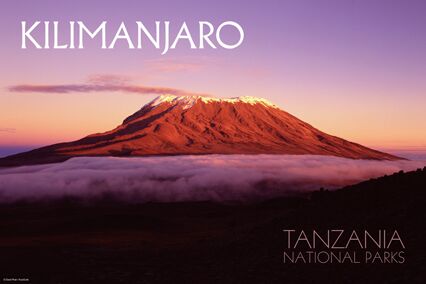
The local people, the
Wachagga, don't even have a name for the whole massif, only Kipoo (now known as
Kibo) for the familiar snowy peak that stands imperious, overseer of the
continent; the summit of Africa.
Kilimanjaro, by any name, is a metaphor for the compelling beauty of East
Africa. When you see it, you understand why. Not only is this the highest peak
on the African continent; it is also the tallest free-standing mountain in the
world, rising in breathtaking isolation from the surrounding coastal scrubland
– elevation around 900 meters – to an imperious 5,895 meters (19,336
feet).
Kilimanjaro is one of the world's most accessible high summits, a beacon for
visitors from around the world. Most climbers reach the crater rim with little
more than a walking stick, proper clothing and determination. And those who
reach Uhuru Point, the actual summit, or Gillman's Point on the lip of the
crater, will have earned their climbing certificates.
![]()
I’ve
chosen the best operator to lead your trek.
Thomson
is the best choice for a trek to the "Roof of Africa".
They are dedicated to providing the highest quality and safest Kilimanjaro treks
available.
With over 24 years of experience, they have the tools and the know-how to back
up their words.
 We
specialize solely in running Kilimanjaro treks and safaris to Tanzania's
magnificent wildlife parks. Our focus affords an expertise that other companies
can't match. We've
guided safaris in
We
specialize solely in running Kilimanjaro treks and safaris to Tanzania's
magnificent wildlife parks. Our focus affords an expertise that other companies
can't match. We've
guided safaris in
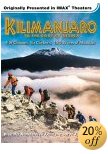 the
Tanzanian bush and guided trekkers up the slopes of Kilimanjaro for over 22
years. We've worked out the kinks. Our Tanzanian guides are rigorously trained
by us, and impart their knowledge with passion and reverence.
the
Tanzanian bush and guided trekkers up the slopes of Kilimanjaro for over 22
years. We've worked out the kinks. Our Tanzanian guides are rigorously trained
by us, and impart their knowledge with passion and reverence.
The 9-day Western Breach Route is the route chosen by David Breashears for
the IMAX film: “Kilimanjaro - To the Roof of Africa”.
"For the Kilimanjaro IMAX film, I
chose the Western Breach Route for its
rugged terrain and astonishing beauty. - David Breashears, Director of Kilimanjaro: To the Roof of Africa
It’s a world-class trekking experience, with a high camp amidst towering
glaciers at 18,750 ft., inside Kili’s dormant volcanic crater!
The summit is reached by the mountain’s least traveled route and because
of the short distance from the last camp to the Summit of only 600 ft. you can
trek to the summit in daylight!
Day
2 Arusha National Park:
This morning you will have a climb briefing at KIA lodge before transferring to
your base camp on the west side of Kilimanjaro. The camp is set in under the
spreading branches of Acacia Tortillis nestled near a volcanic cone, which
affords superb sundowners and good views. This day also serves as an
acclimatization day and a day to recover from the long flights.
Overnight: West
Kilimanjaro Camp
Day
3 Forest Camp
After a hearty breakfast and a climb briefing, you’ll be
transferred to the Londorossi Gate (5,900 ft.) to begin your climb. This first
trekking day is through dense rainforest (approx. 80 inches precip / yr), under
the tangled canopy of moss-coated vines, which are home to the black & white
colobus monkey, blue monkey, and a vibrant array of exotic birds. Arrive at your
camp set in the lower heather belt and enjoy a hot dinner in the mess tent.
Trekking: 3-4
Hours Overnight: Forest Camp (9,500 ft.)
Day
4 Shira 1 Camp
Once out of the forest, take a steep track into a Savannah of tall grasses,
heather, and volcanic rock draped with lichen beards. Ascend through the lush
rolling hills below the Shira plateau, finally reaching camp at the edge of the
plateau. The view of Kibo from across the plateau is amazing. Trekking: 5-6
Hours
Overnight: Shira
1 Camp (12,200 ft.)
Day
5 Shira 2 Camp
Full day exploration of the Shira plateau. Trek east
toward Kibo’s glaciated peak. Arrive at Shira 2 camp. Shira is one of the
highest plateaus on earth, averaging 12,500 feet. Trekking: 3-4
Hours Overnight: Shira
2 Camp (12,600 ft.)
Day
6 Moir Camp
After breakfast you will continue along the Shira Ridge en
route to Moir Camp. The camp is nestled below a large bluff surrounded by cliffs
in the upper heather zone. Trekking: 3-4
Hours Overnight: Moir Camp (13,800 ft.)
Day
7 Lava Tower Camp
Proceed steadily upward over expansive ridgelines of high
desert to our camp set in a striking spot at the base of Lava Tower. You can
test your ardor by climbing to the top of Lava Tower for spectacular panoramas.
Trekking: 3-4
Hours Overnight: Lava
Tower Camp (15,100 ft.)
Day
8 Arrow Glacier Camp
Today
you’ll wake a bit later, and take a short hike to your next camp, up a steep
boulder-strewn path to Arrow Camp. All that remains of the Arrow Glacier and
Little Breach Glacier here are some snow patches and terminal moraine, but
nowhere on the mountain is there a more spectacular view of the Western Breach
headwall, which glows red in the setting sun. The weather
here is often windy and constantly changing, with snow squalls and freezing
temperatures. Trekking: 1-2
Hours Overnight: Arrow Glacier Camp (16,100 ft.)
Day
9 Crater Camp
Today presents the toughest challenge of the entire trek,
as you’ll wake at about 5am to begin your day in darkness. You’ll leave camp
at first light (about 6am), and scramble nearly 3,000 ft. up the Western Breach.
You’ll come over the top of the Breach wall in 5-6 hours, and then another 30
minutes to your camp, which is set in the wide crater of Kili’s summit, amidst
the indigo-streaked Furtwangler glacier, in an arctic moonscape. In the
afternoon, you have the option to explore Reusch Crater and the ash pit. Trekking: 6-8
Hours (Optional 3-Hour Trek to Reusch Crater)
Overnight: Crater Camp (18,750 ft.)
Day
10 Summit Mount Kilimanjaro
Arise with hot tea and some breakfast, and then amble your
way up the last 600 feet to Uhuru Peak (19,340 ft.). Descend the Mweka Route to
Barafu Camp for lunch, then continue to your camp nestled in thick heather on
the southern slopes. Trekking: 1-2
Hours to Summit / 5-7 Hours to Reach Mweka Camp
Overnight: Mweka
Camp (11,000 ft.)
Day
11 Depart Tanzania
Complete your descent through the rainforest to the Mweka
Gate, where you will be met and transferred back to your lodge for a much-needed
shower and some merry convalescence. For those not continuing on safari, you
will be transferred to the airport this evening for your flight to Amsterdam. Trekking: 2-3
Hours Day Use: KIA
Lodge
Asante Sana
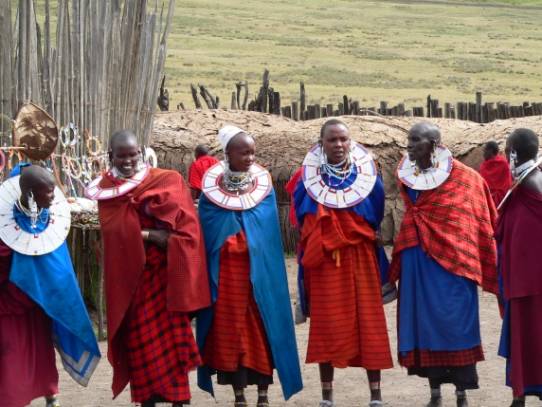
Hakuna Matata
